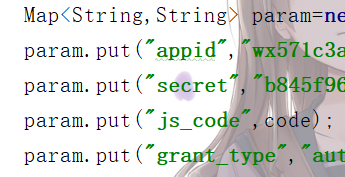微信小程序登录
先来看看流程图
上图就是微信小程序登录的过程,我们只先看上半部分,调用拉取微信自动获取的登陆方法
- 首先需要在微信开发者工具里的.js的wx.login方法来获取一个存在5分钟的code
- 然后我们把这个code发到后台,用于下一步换取session_key+openid
- 我们在后端服务器中封装一些参数去请求wx换取session_key+openid
- 得到数据存到一个对象里,再存到数据库中,完成登录并获取用户唯一指定openid和session_key
我们来看一下具体实现
wx.login({
success: function(res){
console.log(res)
//获取临时凭证
var code=res.code;
//调用后端,获取微信的session_key,secret
wx.request({
url: 'http://127.0.0.1:8092//api/v1.0/songlists/user/wxLogin?code='+code,
method: "POST",
success: function(result){
console.log(result);
}
})
}
})
},
先调用login来获取用户code,在返回的res里面存code,然后我们加到访问请求url中’http://127.0.0.1:8092//api/v1.0/songlists/user/wxLogin?code=’+code
其中/api/v1.0/songlists/user/wxLogin这是请求后端地址
根目录

wxLogin方法

带了一个code参数在url中
后端(springboot项目)
@PostMapping("/wxLogin")
public CommonReturnType wxLogin(String code){
System.out.println("wx-code: "+code);
String url="https://api.weixin.qq.com/sns/jscode2session";
Map<String,String> param=new HashMap<>();
param.put("appid","xxxxxxxxx");
param.put("secret","xxxxxxxxx");
param.put("js_code",code);
param.put("grant_type","authorization_code");
String wxResult=HttpClientUtil.doGet(url,param);
System.out.println(wxResult);
WXSessionModel wxSessionModel= JSON.parseObject(wxResult,WXSessionModel.class);
redisService.set("user-redis-session: "+wxSessionModel.getOpenid(),wxSessionModel.getSession_key());
//
return CommonReturnType.creat(null);
}
这里是服务端请求微信的url

但是这里参数并不完全,所以我们用了工具类HttpClientUtil来封装url请求
这里给出工具类,大家自行copy
package com.fehead.songs.utils;
import org.apache.http.NameValuePair;
import org.apache.http.client.entity.UrlEncodedFormEntity;
import org.apache.http.client.methods.CloseableHttpResponse;
import org.apache.http.client.methods.HttpGet;
import org.apache.http.client.methods.HttpPost;
import org.apache.http.client.utils.URIBuilder;
import org.apache.http.entity.ContentType;
import org.apache.http.entity.StringEntity;
import org.apache.http.impl.client.CloseableHttpClient;
import org.apache.http.impl.client.HttpClients;
import org.apache.http.message.BasicNameValuePair;
import org.apache.http.util.EntityUtils;
import org.springframework.context.annotation.Bean;
import org.springframework.context.annotation.Configuration;
import java.io.IOException;
import java.net.URI;
import java.util.ArrayList;
import java.util.List;
import java.util.Map;
public class HttpClientUtil {
public static String doGet(String url, Map<String, String> param) {
// 创建Httpclient对象
CloseableHttpClient httpclient = HttpClients.createDefault();
String resultString = "";
CloseableHttpResponse response = null;
try {
// 创建uri
URIBuilder builder = new URIBuilder(url);
if (param != null) {
for (String key : param.keySet()) {
builder.addParameter(key, param.get(key));
}
}
URI uri = builder.build();
// 创建http GET请求
HttpGet httpGet = new HttpGet(uri);
// 执行请求
response = httpclient.execute(httpGet);
// 判断返回状态是否为200
if (response.getStatusLine().getStatusCode() == 200) {
resultString = EntityUtils.toString(response.getEntity(), "UTF-8");
}
} catch (Exception e) {
e.printStackTrace();
} finally {
try {
if (response != null) {
response.close();
}
httpclient.close();
} catch (IOException e) {
e.printStackTrace();
}
}
return resultString;
}
public static String doGet(String url) {
return doGet(url, null);
}
public static String doPost(String url, Map<String, String> param) {
// 创建Httpclient对象
CloseableHttpClient httpClient = HttpClients.createDefault();
CloseableHttpResponse response = null;
String resultString = "";
try {
// 创建Http Post请求
HttpPost httpPost = new HttpPost(url);
// 创建参数列表
if (param != null) {
List<NameValuePair> paramList = new ArrayList<>();
for (String key : param.keySet()) {
paramList.add(new BasicNameValuePair(key, param.get(key)));
}
// 模拟表单
UrlEncodedFormEntity entity = new UrlEncodedFormEntity(paramList);
httpPost.setEntity(entity);
}
// 执行http请求
response = httpClient.execute(httpPost);
resultString = EntityUtils.toString(response.getEntity(), "utf-8");
} catch (Exception e) {
e.printStackTrace();
} finally {
try {
response.close();
} catch (IOException e) {
e.printStackTrace();
}
}
return resultString;
}
public static String doPost(String url) {
return doPost(url, null);
}
public static String doPostJson(String url, String json) {
// 创建Httpclient对象
CloseableHttpClient httpClient = HttpClients.createDefault();
CloseableHttpResponse response = null;
String resultString = "";
try {
// 创建Http Post请求
HttpPost httpPost = new HttpPost(url);
// 创建请求内容
StringEntity entity = new StringEntity(json, ContentType.APPLICATION_JSON);
httpPost.setEntity(entity);
// 执行http请求
response = httpClient.execute(httpPost);
resultString = EntityUtils.toString(response.getEntity(), "utf-8");
} catch (Exception e) {
e.printStackTrace();
} finally {
try {
response.close();
} catch (IOException e) {
e.printStackTrace();
}
}
return resultString;
}
}
接着上面来说,给map里传入四个参数:appid,secret,js_code,grant_type.
这里填你自己小程序的信息,appid与secret都能在你的微信公众号开发里面找到

然后这一步我们调用工具类将参数传进去
String wxResult=HttpClientUtil.doGet(url,param);
可见返回的是一个string类型的session_key与openid
存到数据库中(redis)
刚得到一个字符串类型的,但是我们需要把他转化为一个对象
这时候需要我们用到一个新建一个model类,里面放着session_key与openid,这里省略get/set方法

然后,我们把上面的字符串转化为对象,用到了反序列化的JSON.parseObject方法,参数前面为将要转化为的字符串,后面跟着转化为哪个类.
WXSessionModel wxSessionModel= JSON.parseObject(wxResult,WXSessionModel.class);
到了最后一步了,我们需要存到redis数据库中,这里不再讲述如何整合springboot与redis可参照springboot整合redis这篇文章,我们这边直接就用里面的方法
我们刚存到一个WXSessionModel类中,我们直接调用它取出得到的Openid与Session_key来存到redis中
redisService.set("user-redis-session: "+wxSessionModel.getOpenid(),wxSessionModel.getSession_key());
这下我们来看下结果

这里在redis里面我们看见了已经存好的openid与session_key,可以设置过期时间.
这里就简单的实现了微信小程序的登录操作
